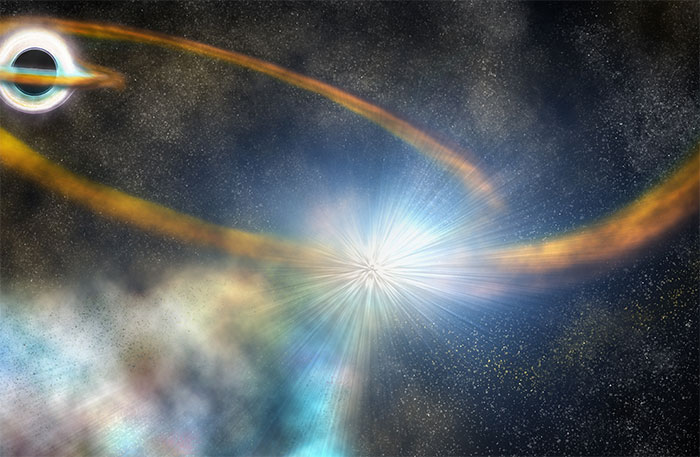NASA's planet hunter finds a black hole ripping apart a star
TESS, NASA's $ 200 million telescope, observes a black hole 600 million times more massive than the Sun "eating" the star located 375 million light-years from Earth.
For the first time, NASA's TESS space telescope encounters a star ripped apart by a supermassive black hole. This black hole is about 6 million times more massive than the Sun, at the center of galaxy 2MASX J07001137-6602251 in the constellation Volans 375 million light years ago. The star is most likely about the size of the Sun.

Simulate black holes ripping stars.(Photo: CNN).
When stars get too close to the black hole, they can't escape the gravity of the black hole and get torn apart. Some matter shoots into space. The rest becomes food for the black hole, which is sucked into the hot accretion disk generated from its gas. This is a tidal interruption event or TDE. This rare event occurs only 10,000 - 100,000 years apart in large galaxies like the Milky Way. Observing TDE is extremely difficult.
TDE causes the black hole to emit a powerful flash of light. The wide and continuous observations of the TESS space telescope detail the star's outcome in an event called ASASSN-19bt . The finding from TESS was published by the team at Ohio University on July 26 in the Astrophysical Journal.
The researchers continue to use many telescopes on the ground and in space to observe the event, recording the different wavelengths of light carrying information about the speed and composition of the star. The team observed the event for 42 days before the brightness of ASASSN-19bt peaked and extended for 37 days thereafter.
Event research not only provides a new understanding of black holes but also helps to understand the unusual nature of TDE. The star's temperature dropped by 50% from 39,705 degrees C to 19,705 C in just a few days.
Since launching in April 2018, NASA's $ 200 million TESS space telescope continues its mission to hunt the planet of the Kepler telescope. In search of exoplanets, TESS surveyed the stars. TESS is studying the sky 400 times larger than Kepler's view, including 200,000 brightest stars nearby.
- The star's painful death was ripped apart by a supermassive black hole
- Experiment with the theory of relativity on a star near a supermassive black hole, Einstein was once again right
- Video: The moment the super black hole ripped and swallowed a star
- Incidentally the star forms near a black hole
- The first time a black hole was discovered, it swallowed a star
- Catching a super rare scene in the universe: Super giant black hole is swallowing up a star
- The star flies more than 1,000 km / sec after 'hiding' from the black hole
- Satisfying the red star scene label N6946-BH1 entered the monster black hole
- New findings help prove the theory of black holes
- Simulating the process of cosmic black holes
- Science warns super giant black holes that can
- The black hole tore apart the star
- Snatching up the image of a choking cosmic black hole when swallowing a star
- Black hole detection
 Van Allen's belt and evidence that the Apollo 11 mission to the Moon was myth
Van Allen's belt and evidence that the Apollo 11 mission to the Moon was myth The levels of civilization in the universe (Kardashev scale)
The levels of civilization in the universe (Kardashev scale) Today Mars, the sun and the Earth are aligned
Today Mars, the sun and the Earth are aligned The Amazon owner announced a secret plan to build a space base for thousands of people
The Amazon owner announced a secret plan to build a space base for thousands of people